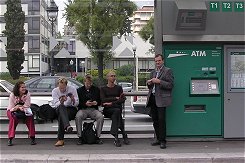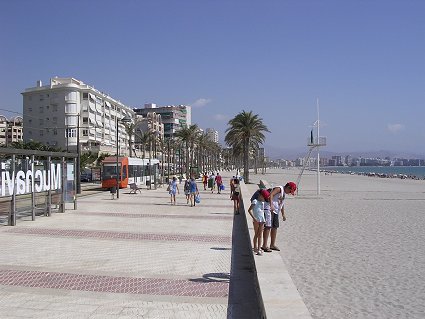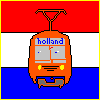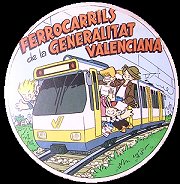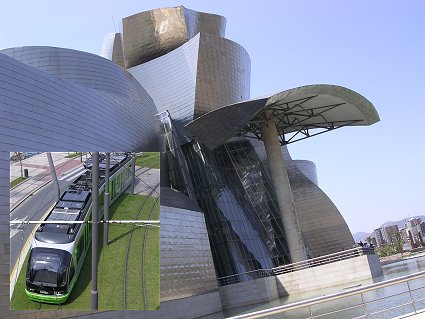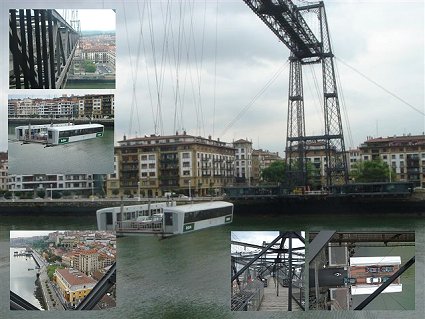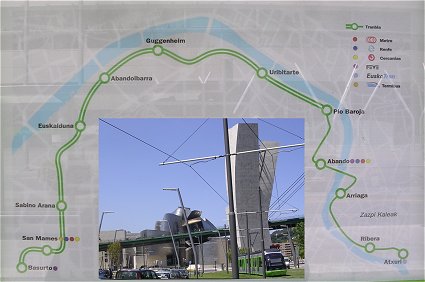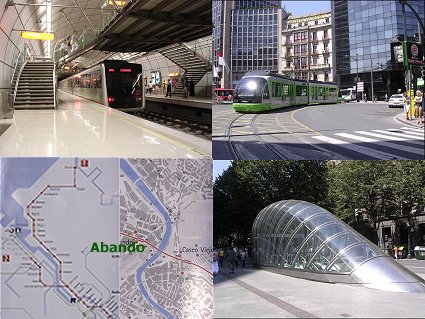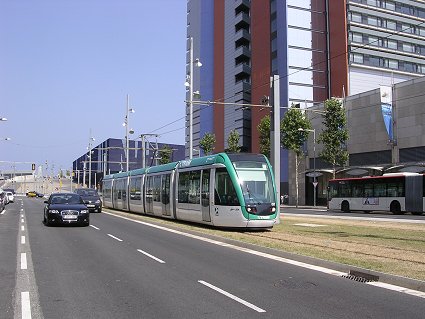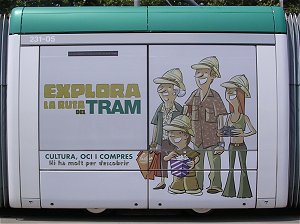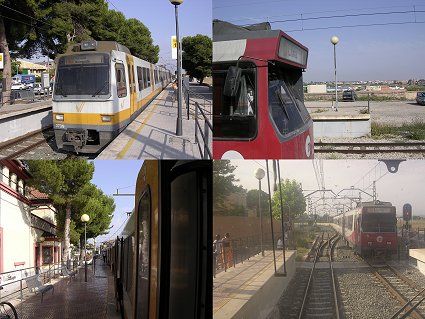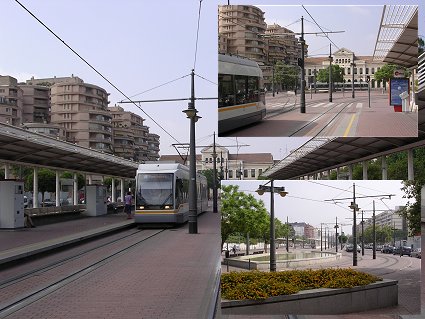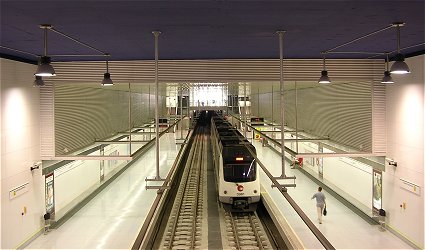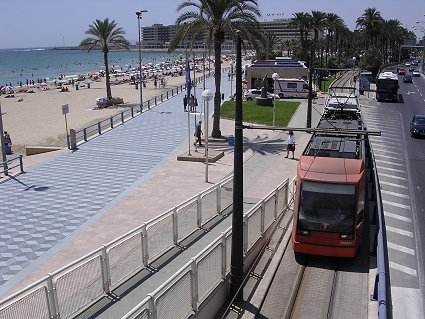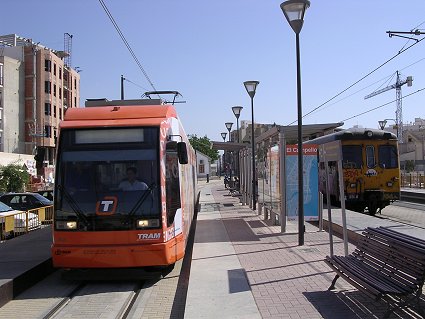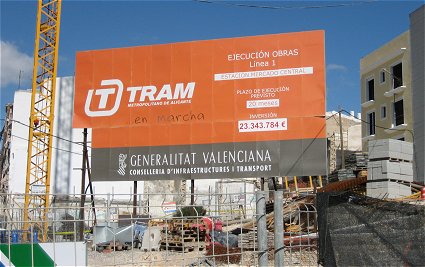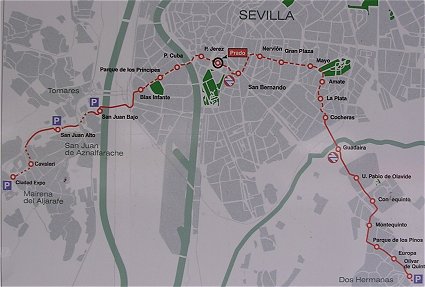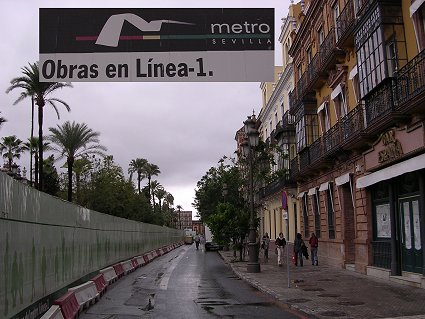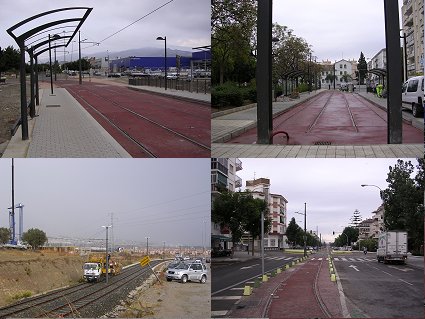TRANSIT in Spain
Part of our Spanish Study Tour Programs
This webpage offers background information on developments regarding light rail and high quality public transport in Spain. The revised version is extended with a Recent Developments section.
A previous version of this webpage was made to support the Norwegian tour 'Public Transport & Urban Planning in Spain - Barcelona, Valencia & Alicante' (October 4-9, 2005). This tour was assigned by 'Oslopakke 2' (Oslo, Norway) and has been prepared by Rob van der Bijl (Amsterdam, Holland) and Axel Kuehn (Karlsruhe, Germany) .
Photos: (C) Lightrail.nl/Rob van der Bijl & AS Oslo Sporveier/Terje Grytbakk
Barcelona, October 5, 2005
Oslo's 'O2-group' on duty; mr. Joaquim M. Bestit (Gerent of TRAMBAIX & TRAMBESÒS; standing right) delivering an excellent presentation.[menu] (or read introduction below) (C) Lightrail.nl / Rob van der Bijl, August-October 2005 update: 241005
Introduction
The Spanish light rail scene has been changed dramatically. Light rail plays a key role - as for instance the new systems in Alicante, Barcelona and Valencia prove. We like these new systems and invite you to join us on our study tours to these fine cities and their rapidly improving public transport.
This webpage offers some background information on the Spanish light rail scene, as well as a case study on the new tramway of Bilbao and some additional information on transit of Alicante, Barcelona and Valencia, as well as some other cities.
Please, e-mail LRNL/Rob van der Bijl for your questions.
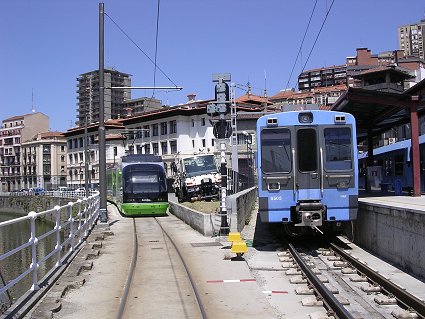
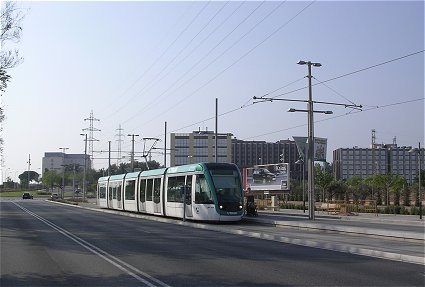
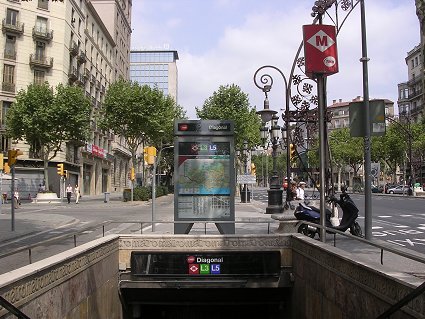
DOCUMENT: (C) Lightrail.nl, August 2005This document supports RVDB's study tours.
This document consists of 8 parts. Please, use the menu to jump to the part you wish to view.
New Public Transport Case Study: Bilbao Example 1: Barcelona Example 2: Valencia Example 3: Alicante Recent Developments Links Study Tours
1. New Public Transport, or back to: [intro] [menu]
Booming economy: Guggenheim Museum served by new tram
Photo: (C) Lightrail.nl/Rob van der Bijl
Bilbao, July 21, 2005Spain's economy is booming and so its cities expand rapidly. It comes to no surprise that new public transport is under construction or in planning in the urban regions and cities all over the country. The metro system of Madrid has been enlarged impressively. The city of Bilbao got a new metro, while many lines of Barcelona's metro are or will be extended.
Nearly all new and improved public transport is rail-based. Light rail plays and will play a key role in this respect. During the last years new tramways have been opened in Valencia, A Coruña, Bilbao, Barcelona and Alicante (Alacant). And new light rail projects are under construction or in planning (August 2005). Madrid will get three 'feeder' tramway systems. The Alicante tramway will be transformed into a regional network along the 'Costa Blanca', serving Benidorm, Denia and many other places. Under construction are the new systems of Sevilla, Santa Cruz de Tenerife and Vélez-Málaga. Under investigation or in planning are tramways in Granada, Málaga, Murcia, Palma de Mallorca, Ribes-Nuria, San Sebastián (Donostia), Santander, Vitoria-Gasteiz and perhaps other places too.
The Spanish light rail scene has been changed dramatically. After the post-war demolition of all tramways, except the tourist oriented tram of Sóller (Mallorca) and Barcelona's touristic 'Blue Tram', the light rail landscape was empty in Spain. All that remained were some regional railways, like in the urban areas of Barcelona, Valencia and Bilbao. However, today's projects prove that rail-based public transport is essential for a flourishing economy.
2. Case Study: Bilbao, or back to: [intro] [menu]
Photos: (C) Lightrail.nl/Jaap Modder, Bilbao, October 11, 2005Bilbao got a lot of new things, but this city is famous due to its old 'bridge', a people mover 'avant la lettre'. At Portugalete this public transport device is still in operation, despite it's the world's oldest 'transport brdige', dating from 1893.
The city of Bilbao owns a new, two-line metro system and a new tramway (Euskotran). The region of Bilbao is served by a light railway network (Euskotren). Our case study focuses on Euskotran. Unfortunately this study is still pending (2005-2007), but we like to present some results already.
Budget for "Bilbao Tramway Line A", Atxuri-San Mamés stretch, PHASE 1
BILBAO CITY COUNCIL 11,75% 2.400.995 Euros
BILBAO - RIA 2000, S.A. 23,50% 4.801.991 Euros
BASQUE GOVERNMENT
Dept. of Transport and Public Works 64,75% 13.231.018 Euros
According to Euskotran suburban trains, the metro and the tramway currently form three essential pillars for the development and revitalisation of Bilbao as a modern city. "After many years went the tram has been rediscovered as an ideal alternative for the future. Quite a paradox for a means of transport unfairly branded as an anachronism and taken out of service during the 50s and 60s in cities which gave their streets and avenues over to private cars. Today, the Tramway is the alternative to pollution-generating forms of transport in city centres. Surface transport which does not need large infrastructures or heavy investment costs. Transport which travels the streets along reserved spaces or in company with other vehicles. Without limits, because its versatility enables it to adapt to any type of urban surface, be it tarmac, paving stones, stone, sand or grass...
These are the most significant advantages of the Tramway, although the economic benefits that this system brings to a city are no less important: it improves access to cities with resulting savings in time and fuel costs, and strengthens the development of cores of commercial activity. The Tramway thus becomes a driving force for a city‚s urban and social transformation."
Photo & Map: (C) Lightrail.nl/Rob van der Bijl
Bilbao, July 21, 2005The new tramway serves an urban renewal area. The fancy building of the Guggenheim Museum attracts many visitors. According to Euskotran the tramway relieves congestion in the Abando district on the left bank of the estuary, a dense urban environment. The tramway also helps restructuring of the Abandoibarra zone, which, again according to Euskotran, "is the subject of a great transformation and in need of new transport infrastructures. Euskotran will as a result encourage new areas of economic activity, where industry, services, housing, and public facilities and spaces will all blend and complement each other."
Photo: (C) Lightrail.nl/Rob van der Bijl
Bilbao, July 21, 2005Euskotran and Euskotram are operated by the same company. However, no through service by means of tram-train is considered yet. On May 8, 2002, C.A.F. delivered the first unit of the Bilbao tram vehicle. These trams have been designed taking into account the latest technological developments and the requirements of the city and the users, according to Euskotran. "Access to the units will always be at platform level, therefore facilitating the mobility of all passengers. Each unit will include 4 access and exit doors, which will reduce the time the units are stopped for passengers to get on and off trams. The units are 25 metres long. Each unit has been designed to transport 192 persons, of which 50 will be seated. There are reserved areas on the trams for persons with impaired mobility. Inside each unit, passengers will find a similar layout as on the most modern units dedicated to urban transport
The units include double air-conditioning systems as well as a centralised public address system to broadcast music, information on the next stop and special messages. There will be two electronic information panels to provide data on the next stop and other information."
Photos & Maps: (C) Lightrail.nl/Rob van der Bijl
Bilbao, July 21, 2005Metro stop Abando offers interchange with the tramway. Running every 5 to 10 minutes, the service offered by the new tramway is used by ten thousand passengers on working days. According to Euskotran (2001) "this figure will rise considerably when the infrastructures planned for Abandoibarra are completed and a combined transport pass for the Bilbao Metropolitan District public transport is established."
3. Example 1: Barcelona, or back to: [intro] [menu]
Photo: (C) Lightrail.nl/Rob van der Bijl
Barcelona, July 24, 2005Since 2004 trams run again in the streets of Barcelona, after more than 30 years of absence. Two networks are built. 'Trambaix' is a new three-line system (T1-3) situated at the south end side of the 'Diagonal', an artery cutting through the whole of Barcelona's urban fabric and part of the famous 'Cerda'-extension of the city.
Photo: (C) Lightrail.nl/Rob van der Bijl
Barcelona, July 24, 2005'Trambesòs' consists of two lines (T4-5), and serves the northern end of the 'Diagonal', including an urban renewal area called 'Forum'. French trams of the Citadis type are used. Project costs (Trambaix and Trambesòs) are 400 million euro.
On the long run both networks will be connected, as well as extended towards the city centre.
Photo: (C) Lightrail.nl/Rob van der Bijl
Barcelona, July 24, 2005Meanwhile the metro is renewed too. The accessibility of the station infrastructure is under improvement, though it will take a long time to adapt the total infrastructure to nowadays standards. A new line is under construction (August 2004). This is not a 'regular' line. It will be one of the longest in the world (43 km) and very expensive (2200 million euro). December 2003 witnessed the opening of the new shuttle line L11 (as extension of L4). Two specially prepared vehicles, though according to standards of the existing fleet, are due to run automatically. August 2005: still no driverless running!
Photo: (C) Lightrail.nl/Rob van der Bijl
Barcelona, July 24, 2005
"Explore the tram route"April 2005: 'Associació per a la Promoció del Transport Públic' (Association for Promotion of Public Transport), reported that the new tramways attract 60% new riders. This is a success as 14% of motorists in service area switched to transit. During the first year of operation (3 April 2004 to 2 April 2005) Trambaix and Trambesòs showed respectively 8.2 and 2,4 million rider-trips, as well as an average weekday ridership of 34,600 and 17,900. Barcelonans are using the trams for several major reasons: faster (50%), clean (28%), nice and accessible (22%).
Trambaix is used for 'regular' trips (school, office, etc.) by 67.2% of riders, and for 'random' trips by 32.8%. On Trambesòs 'regular' users represent 56.8% of passengers and other users
43.2%.
April 2004: Trambaix has an average 'commercial' speed of 16.5 kph, while Trambesòs system provides 19 kph. July 2004: the trams still get no real priority at crossings. October 2005: mr. Joaquim M. Bestit (Gerent of TRAMBAIX & TRAMBESÒS) confirms Lightrail.nl & 'Oslopakke 2' that progress has been made to improve average speed and priority at crossings. But a full priority will never be possible. Expected average speed should be around 20 kph.
4. Example 2: Valencia, or back to: [intro] [menu]
Photo: (C) Lightrail.nl/Rob van der Bijl
Valencia Region, July 28, 2005For many years construction of a cutting edge light rail system in Valencia's region and city is in progress. The first stage of this impressive undertaking comprised the connection of two of the northern regional railways with the southern one by means of a 'metro' tunnel, including several new stations serving the central city. This part of the system is operated as line 1. CAF built LRV's acquired in the late eighties of a type similar to those of the Dutch light rail system in Utrecht provide a range of services between many destinations. A latter stage included the rerouting of another regional railway via a second tunnel. This line is operated as number 3. Rerouting and through running of line 1 and 3 implied the closure of the regional main station at the northern side of the city.
Photo: (C) Lightrail.nl/Rob van der Bijl
Valencia (Pont de Fusta) , July 27, 2005Valencia was the first Spanish city that introduced a modern street based tramway (1994), operated as line 4 of the system. Siemens built low floor trams - of a type similar to that of Lisbon's coastal tramway and Karlsruhe's city trams - serve a route using some portions of the former regional railway's alignments, as well as Valencia's old tramway! New sections are used too. The tramway connects the beach of the city with new urban districts at the north-western side of the conurbation. Halfway the trams are passing 'Pont de Fusta', the old regional railway station (a police station now!). The former yard area has been transformed into a high quality public realm.
Photo: (C) Lightrail.nl/Rob van der Bijl
Valencia (Ayora Station), July 27, 2005Brand-new line 5 represents almost a 'real' metro, and reflects truly the name of the system which is branded as 'Metro'. New tunnels and stations are constructed for this line at the eastern and western side of the central city. But line 5 uses the tunnel of line 1 and 3 in the central area too.
July 2005: construction of a second tramway (future line 2) is in full swing. This line will connect the northern suburb Els Orriols via Punta de Fusta to the city centre. Line 2 will be a street based line, however using a tunnel section under the old city. Inhabitants of the area of Punta de Fusta are opposing to the scheme: banners at the apartment's balconies are showing texts like: "No Metro Superficie".
Valencia shows a rail-based public transport system that integrates features of light rail, tram and metro. Work on this system is still in progress (July 2005). To be continued…
Photo: (C) Lightrail.nl/Rob van der Bijl
Alicante, July 30, 2005Alicante works on its new system called 'Tram'. Since 1999 a tramway serves the city's boulevard. But the real project comprises the conversion of the 93 km coastal railway between Alicante's Maritime Station and the town of Denia.
Photo: (C) Lightrail.nl/Rob van der Bijl
El Campello , July 30, 2005This ambitious undertaking represents Spain's first tram-train project ('tren-tranvía'). On a temporary base the El Campello stop serves as a temporary interchange between new electric tram and old diesel train.
Photo: (C) Lightrail.nl/Rob van der Bijl
El Campello (Boulevard), July 30, 2005In 2003 the tramway of the boulevard is connected through the railway and extended to El Campello, a neighbour town at the north-east side of Alicante. In July 2005 large portions of the further conversion of the railway to tramway were finished. So, Benidorm and Altea will be served by the tramway in due time (2006). On the long run the Alicante tramway will be transformed into a regional network along the 'Costa Blanca', serving Benidorm, Denia and many other places. For instance, local services are planned in Benidorm (e.g. to the beach) and Alicante (e.g. to the main station, using a newly built tunnel, and the university). Even the rebuilding of the former railway between Denia and Gandía (25 km, closed in 1973) is part of the scheme.
Photo: (C) AS Oslo Sporveier/Terje Grytbakk
Alicante centre (Mercado), October 9, 2005Participants of the 'Oslopakke 2' (Oslo, Norway) noticed work in progress during their site visits in Alicante (October 2005). 'Mercado Central', one of the new centre stations along the future Line 1, is under construction.
6. Recent Developments, or back to: [intro] [menu]
Spain still has a long way to go to bring its public transport quality on an acceptable level. Though, despite strong car oriented policies in every major city the improvement of public transport seems to have high priority too. Sevilla is a clear example of this (new) priority. The expo of 1992 in this famous city could not 'rescue' the metro scheme, but at last a new revised, light rail oriented plan is under construction since 2003 (using tunnel sections already built in the early nineties!).
Map: Metro Sevilla
Red - surface alignment; Red dotted - underground alignment
Line 1: 18,9 km; 23 stations; low platforms
Prado construction area (October 2005) high lightenedThe 18,9 km Line 1 serves 26,6 % of greater Sevilla's 858.000 inhabitants, living in four municipalities. This first line will run through the city along an east-western alignment which is party underground, using low platforms though.
Photo: (C) Lightrail.nl/Rob van der Bijl
Sevilla, October 11, 2005The historic city with its narrow streets and busy traffic is crossed entirely underground. The construction of Line 1 is estimated to cost 428,5 thousand euro (October 2005).
Photo: (C) Lightrail.nl/Rob van der Bijl
Vélez Málaga, October 10, 2005Yet another scheme: Vélez-Málaga (60.000 inhabitants). A 4,76 km tramway is under construction. The line connects the centre of Vélez-Málaga to the coastal town of Torre del Mar, serving a huge mall and a major hospital. Unfortunately both Vélez-Málaga's centre on the one end, and the beach on the other end of the line are remotely situated. However, extensions are planned.
The 18 million project is nearly finished (October 2005), but it is still unclear when the new system will open, as no real decision has been made on the vehicles. It could be for instance trams of CAF, according to the Bilbao-type or to the new type for Sevilla.
7. Links, or back to: [intro] [menu]
BILBAO
www.euskotran.es/
www.euskotren.es
BARCELONA
www.atm-transmet.org
www.trambcn.com
www.fgc.net/
www.tmb.net/
www.tramvia.org/
VALENCIA
www.metroValencia.com
ALICANTE
www.fgvalicante.com
VÉLEZ-MÁLAGA
www.ayto-velezmalaga.es
www.ayto-velezmalaga.es/portal/tranvia.php
MÁLAGA
www.metrodemalaga.info
SEVILLA
www.metrodesevilla.net
RAILWAYS
www.renfe.es
8. Study Tours,or back to: [intro] [menu]

E-mail your questions and suggestions...
LRNL
THE STUDY TOUR LINK
www.lightrail.nl/studytours (Rob van der Bijl & Axel Kuehn)
SHORT STUDY TOURS
LRNL now offers cheap guided Light Rail-tours to European cities like Amsterdam, Rotterdam, Antwerp, Lille, Orléans, Paris, Strasbourg, Cologne, Bonn, Karlsruhe and Saarbrücken.
Feel free to write to LRNL excursions.
OVERVIEW PROGRAM OF LARGER TOURS
LRNL offers Light Rail-excursions world-wide, using its international network of LR-experts.
Each program is characterized by its most important cities. However, cities can be removed or added.
Northwestern Europe
Düren - Cologne/Bonn - Ruhr area;
Hannover - Kassel - Bielefeld;
Saarbrücken - Strasbourg - Nancy;
Orléans - Nantes - Paris;
Saarbrücken - Karlsruhe/Heilbronn - Stuttgart;
Belgium coast - Lille - Gand - Antwerp;
Londen - Birmingham - Manchester - Sheffield - Nottingham;
Manchester - Liverpool - Dublin;
Paris - Rouen - Lille - Valenciennes.
Middle and southern Europe
Basel - Zürich - Bern - Lausanne - Genève;
Milan - Turijn - Genova;
Napels - Messina;
Valencia - Barcelona - Bilbao.
Eastern Europa
Poznan - Lodz - Warsaw - Krakow;
Prague - Most - Plzen - Brno;
Helsinki - Petersburg;
Moscow - Noginsk - Kolomna;
Kiev - Dnepropetrovsk.
Northern America
Portland - Seattle - Vancouver;
Calgary - Edmonton - Toronto;
San Francisco - Los Angeles - San Diego;
San Francisco - San Jose - Sacramento - Salt Lake City - Denver;
Boston - Newark - New Jersey - Philadelphia - Baltimore;
Boston - Buffalo - Pittsburgh - Cleveland
New Orleans - Memphis - Dallas
Southern Amerika
Buenos Aires - Curitibá - Rio de Janeiro
Africa
Tunis;
Johannesburg - Durban - Capetown (urban planning);
Asia
Hong Kong (city) - Hong Kong (Tuen Mun) - Manilla;
Tokyo - Kyoto - Hiroshima.
Australia
Sydney - Melbourne - Adelaide.



DOCUMENT: (C) Lightrail.nl, August 2005
